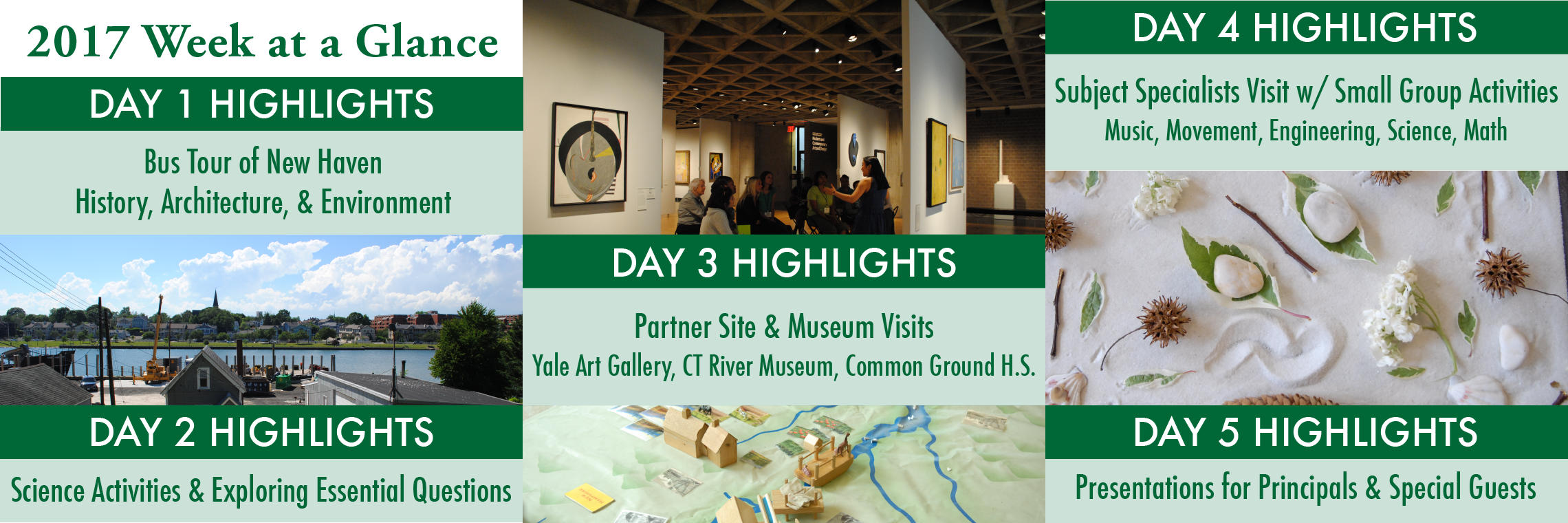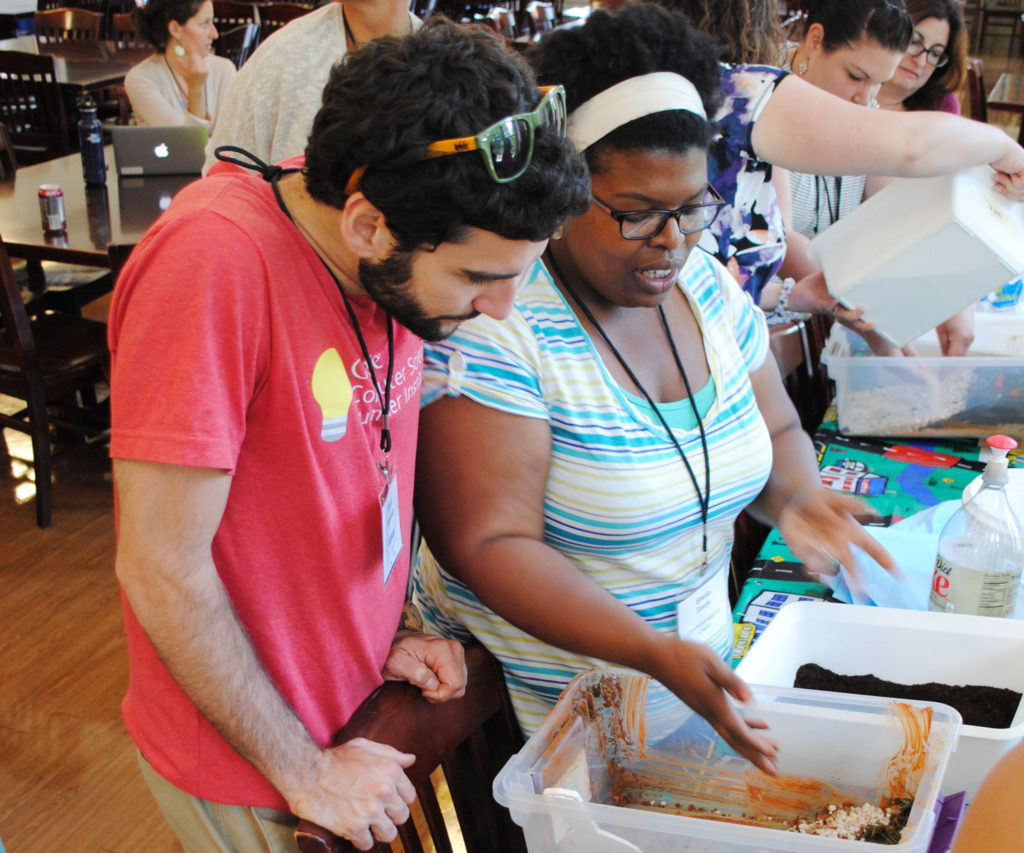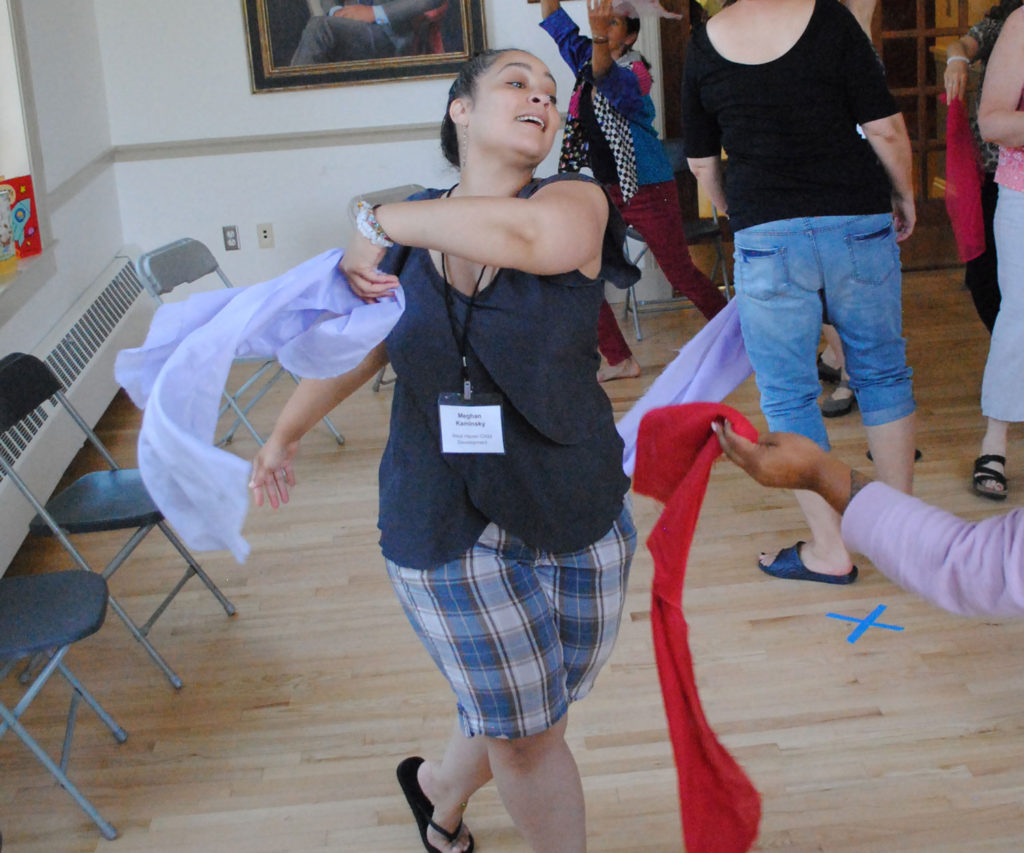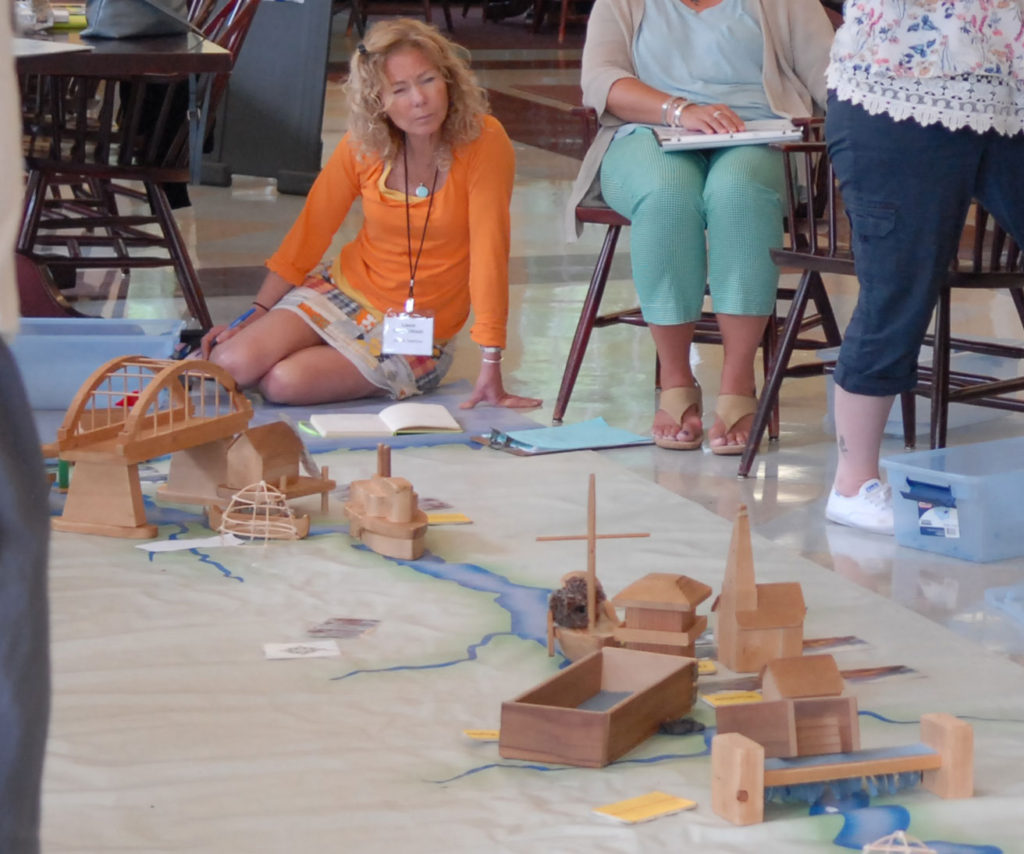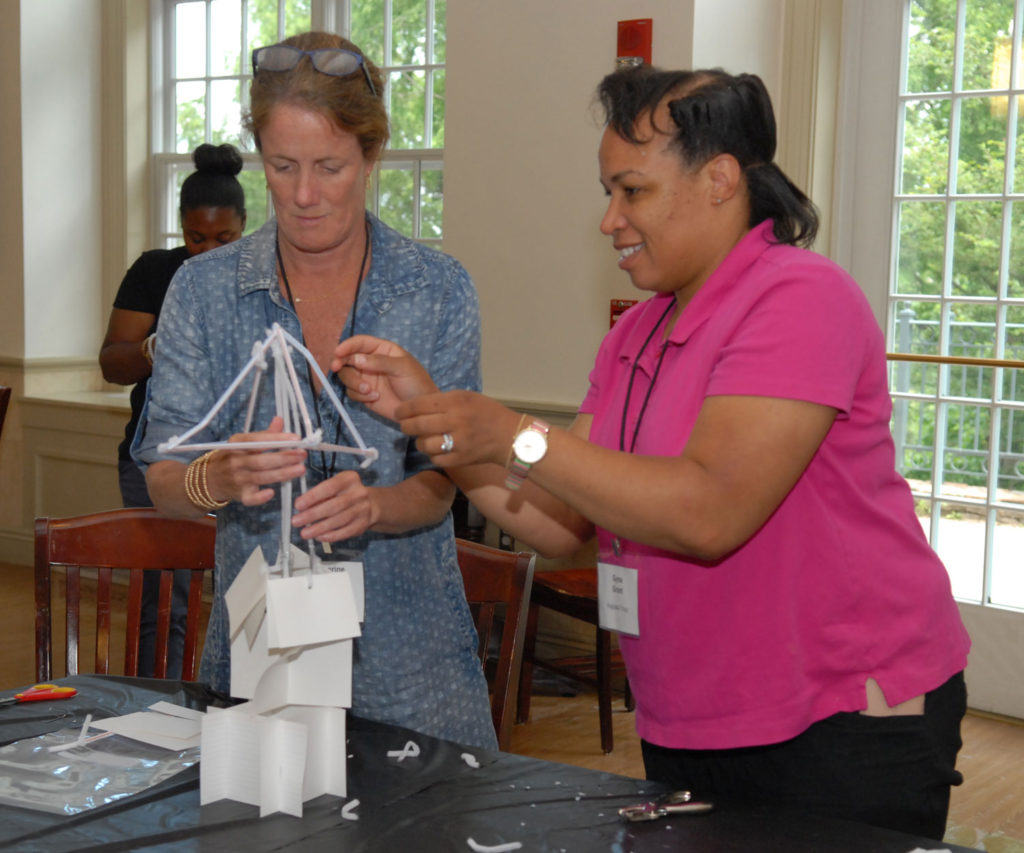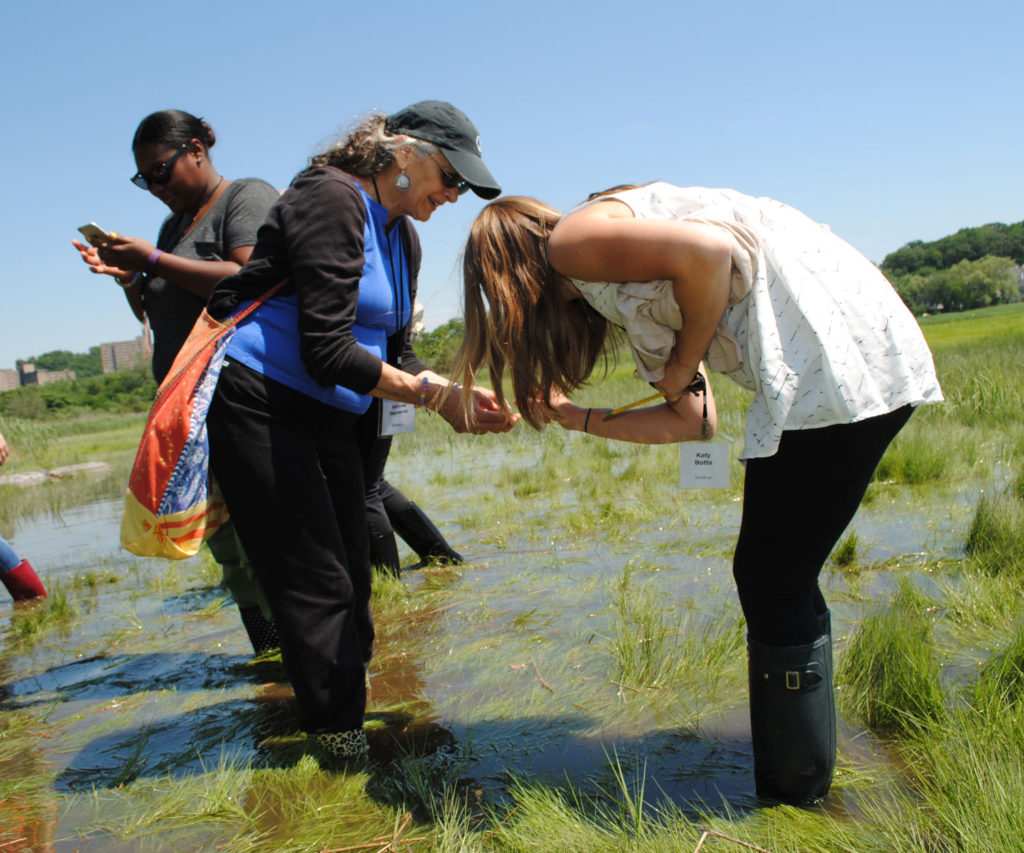Summer Workshop: A Week of Collaboration, Learning, and Play
At the beginning of every summer, a talented collective of seasoned educators gathers together to share their wealth of experience in place-based education and integrated Science, Technology, Engineering, Arts, and Math (STEAM) curriculum with New Haven County and surrounding area teachers. In 2017, the Seedlings Educators Collaborative Workshop brought together a diverse group of 47 Pre-K- through sixth-grade teachers who chose to spend the beginning of their summer break learning how to better leverage their own interests, and their students’ natural curiosities, to develop curriculum that teaches 21st-century skills and meets state standards. They represented a wide range of ages, grades taught, number of years teaching, ethnicity and schools. Some were looking for ideas for working within seemingly rigid standards. A few had been encouraged to attend by supportive administrators. All were enthusiastic educators committed to helping their students learn. “We have a bit of a self-selected group who want to spend five days with us right after they finish the school year, and so for those people who want to return to the passion that brought them into education, and rethink who they are as educators and what they are trying to do, we provide a safe, supportive space for that,” says Seedlings Educators Collaborative director Judy Cuthbertson.
The collaborative originated from Seedlings Foundation co-founder and president Karen Pritzker’s respect for educators and awareness of unmet needs in the profession. Pritzker thought, “Most other professionals have a chance to get away from their everyday work environment and collaborate with other professionals in a comfortable location, with quality facilitators and good food. Teachers don’t get that same treatment, and yet they need that opportunity to grow and learn from other colleagues and experts in their field.” With a team of dedicated, lifelong educators like Cuthbertson and former Seedlings Collaborative director and school principal Jean Lamont, the workshop was born. Since 2005, the free-to-attend workshop has gathered a collaborative powerhouse of educators and other experts as facilitators, guests, presenters, and guides. Together, they make the week possible, spending countless hours preparing before, during, and after the workshop to provide the best network of ideas, support and connections to the teachers, and in turn, the students, of New Haven County and beyond. They offer participating teachers a rich environment for an inquiry-based, hands-on, experiential way of learning, where they can ask questions, learn from mentors and colleagues alike, receive support and encouragement, and be willing to learn and engage more by taking risks—a model teachers are encouraged to instill in their own classrooms when school resumes in the fall.
The 2018 Connecticut Teacher of the Year, Erin Berthold, a two-time Seedlings alum and first-grade teacher at Wallingford’s Cook Hill Elementary School, has embraced the Seedlings philosophy and passes it on to her students and colleagues. Berthold champions for her students to take charge of their own learning and empowers them by asking questions and encouraging them to share their own observations and interests—just as Seedlings facilitators teachers to do during the workshop. “Here, I’m the learner and I look at how engaged I feel by the wonderful presenters here who share their excitement and passion, and by working collaboratively with the people in my group—and even talking with people in other groups. I think that can be a model for an entire school—so that the kindergarten knows what the second grade is doing, and so on, and we all work together.” She has shared her classroom with Seedlings in this post from the 2017 school year. Kristine Friend, Berthold’s principal at Cook Hill, sees the benefits to her teachers and the students. “I have been in some of the classrooms where these Seedlings-inspired lessons were taking place, and the level of student engagement is phenomenal—and teachers’ expectations of outcomes is far greater, too,” Friend says. “I also firmly believe that if students are not taking risks and in charge of their own learning, then they are not as engaged.” This, too, is something that teachers learn during their week at Seedlings.

Collaboration, Activities, Community, and Integration
This year, the number of teachers from Cook Hill attending the workshop more than doubled. “I am amazed that we were so fortunate as to have seven of our teachers join this week,” says Friend. “To find them collaboratively giving up part of their summer to work on projects as a team just creates a vision for the future for us.” Those teachers, along with their cohorts from other schools, were assigned to smaller groups to work on grade-specific projects with a facilitator to lead discussions and mentor them for the week, and beyond. The facilitators are experienced in teaching a project-based, integrated STEAM curriculum in their own classrooms, and selected a book to guide them through the week and integrate literature with STEAM components. The integration began right away with an icebreaker activity: collaborating to build a bookstand out of limited materials—newspaper, a clipboard, and masking tape—and a limited amount of time for group organization, design planning, creating and testing their products. The activity could be brought to all ages, from pre-school to even a high school classroom. Like the other activities throughout the week, it encapsulated real-world learning, collaboration, communication, leadership and finding solutions to problems through inquiry, critical thinking and creativity while incorporating all aspects of STEAM education in a seamless way.
The first day concluded with a bus tour of New Haven with city native, author, architect, historian, and entrepreneur Colin Caplan. The tour included two stops: the first at Grannis Island (a.k.a. Quinnipiac Meadows Nature Preserve) to explore with Cold Spring School Master Teacher and Seedlings science and technology coordinator Karen Zwick and meet with New Haven Land Trust’s Executive Director Justin Elicker; and the second at Copps Island Oysters to learn about oyster farming, one of the area’s oldest trades. The afternoon emphasized that local—community, architecture, environment, resources, and more—is important and relevant. Along with those connections to the local aspects, the hosts of the afternoon connected architecture to business and history, and flora and fauna to social studies lessons. The overall take-home quote from many a teacher was, “I didn’t realize all the great places and connections we had access to.”

Each of the following days continued with experts sharing their knowledge and guiding the group through classroom-friendly, integrated STEAM activities. One of those activities was with Bill Yule (speaking with teachers at left) from the Connecticut River Museum. “We built a tin foil boat and talked a little bit about buoyancy and water displacement and the scientific concepts of specific gravity, displacement, and all the things that a boat builder needs to know. The whole experience was a way to have the teachers have some tools to bring back to the classroom to teach science without using fancy scientific terminology in isolation. We had a lot of fun learning about ways to connect with students.” Even though he has retired from the museum, he still comes back to work with the teachers. He returns because, “Out of this experience working with teachers this year and previous years, it makes me feel hopeful about the future. I feel like the children, at least in these schools, are in good hands with this group of teachers.”
Foote School Science Coordinator and Seedlings facilitator Leslie Long brought her years of experience to daily presentations and activities, explaining the scientific method (asking a question and using evidence to answer it) and encouraging teachers to turn student questions into testable experiments to engage them in the learning process. Long’s toolkit includes many lessons that incorporate scientific topics with math, art, business, writing, and other avenues. “Naming isn’t knowing,” Long emphasized to workshop attendees. “In a good science program, major concepts are the importance, where factual knowledge is built through context, and students take some of the responsibility for their learning. You are a guide to help students learn how to ask questions, think about variables, and find answers. I tell my students that they have the right to be wrong. It’s part of the learning process.”
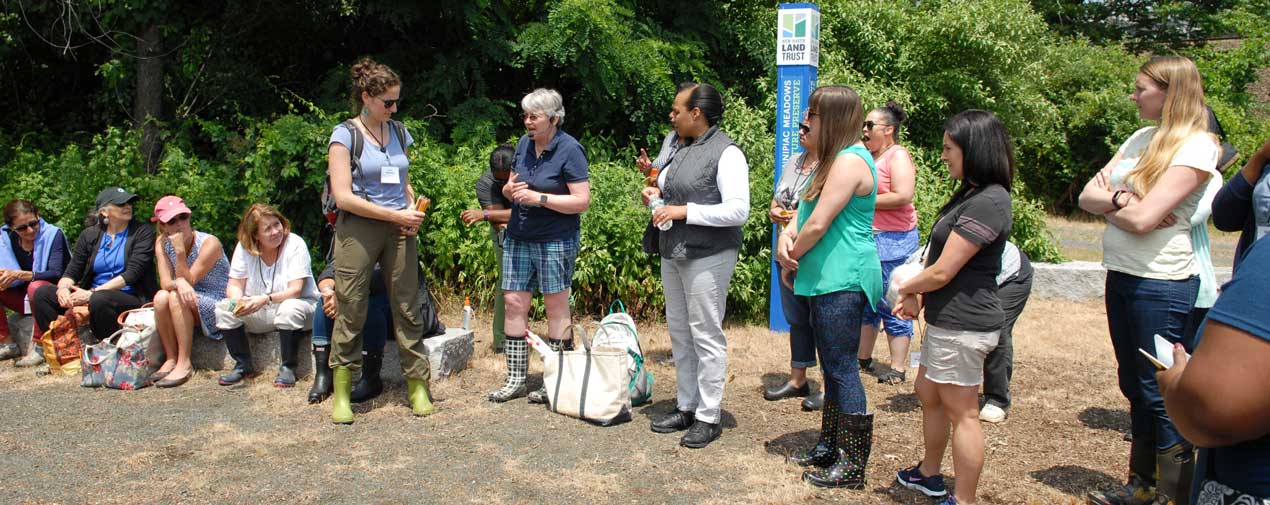
Child Development and Support for Teachers and Students
Putting teachers in the students’ shoes also helps them with understanding where the children are developmentally. Kara Felegian, also a teacher at Cook Hill, was inspired to come after learning what Seedlings brought to Erin Berthold’s classroom. She observed, “I feel like it allows us to go into our students’ brains and be kids again, but from the teacher’s side. So we were able to do activities that we can do with our kids in the classroom; but also, knowing where our students are developmentally, as well as available resources, allowed us to brainstorm about more possibilities that we could do with our kids.” Berthold added that the resources from Seedlings she brings into her classroom also help: “One of my big takeaways from last year was having my students learn from community resources. Having people come into my classroom and watching my students learn from someone else gave me a really good perspective on how they learn.”
To help with ensuring the curriculum possibilities that teachers think up are developmentally appropriate, Cuthbertson invites Associate Director of the Yale Program in Early Childhood Education Nancy Close, who is also Assistant Professor in the Yale Child Study Center, to review developmental principles and theories. Being cognizant that teaching strategies match student’s growth and maturity levels is crucial for their learning success. “Be aware of children’s developmental skills,” advises Close. “Knowing what children are able to do developmentally will inform how you teach learning concepts.” Like Long, Close feels that struggle, conflict, and even failure are important for growth and cognitive development. Providing a safe space for children to do so will allow them to explore and learn important concepts.
The same is true for the teachers who are the ones learning during the workshop. “I really do believe that most teachers really want to get back to what’s right for kids,” Cuthbertson said. “With our support, we bring teachers back to the basics of education and do it in a very accessible, supportive way, and give them all the tools they need to go back into their classroom and feel comfortable trying them out.”
Throughout the workshop—from the week’s activities, food, resources, and especially the team of facilitators and field experts, like architect Alan Organschi, artist Beth Klingher, and dancer Leslie Prodis, to tour guide Colin Caplan and museum specialists like Bill Yule—it is abundantly clear that teachers are valued by all involved. “I believe in teachers,” says Yule. “I come from a background of teachers. My mother was an English teacher for 35 years. My sister was a third-grade teacher for almost 30 years. I was a teacher. Teaching is in my genealogy, I guess you could say. I think teachers and teaching are the key to the future. If we are going to have a sane and healthy future in this world, teachers hold the key to unlocking the potential of young people. I come to Seedlings every year hoping that I can give something to the teachers that they can take back to the classroom to be more effective in teaching skills. It’s as simple as that.”
Taking It Back to the Classroom
Since Seedlings reaches out to teachers in a variety of schools, the workshop ensures that the curriculum and skills that the teachers spend the week developing are readily applicable to their classrooms and meet state standards. “Standards have a dirty connotation, but standards that are well done can inform our thinking and our teaching,” Leslie Long points out. “STEAM is all about integration, and Seedlings is all about integration, too.” Dianne Spence, principal at Conte West Hills Magnet School in New Haven, seconds the notion that place-based learning and standards can co-exist in harmony, each making the other better. “There is an easy connection to all the standards that are in Common Core,” says Spence. “It’s always important for teachers to think about how we can best provide a cohesive education for students. The kind of work that the Seedlings Workshop does allows teachers to think about how to put the separate units that students have to learn in school within the curriculum in a more holistic and meaningful way. It encourages collaboration and inquiry in learning. It really helps students to develop every aspect of their lives in ways that are not as artificial, and it really, more than anything else, provides meaning to learning, and that is what allows people to remember and gain experiences that they will use later on and apply as they go through life.”

A handful of the participants in each summer’s workshop are second-timers and have seen firsthand what Seedlings brings to their teaching and their students. They have experience to share about how they integrated Seedlings into their classroom. Donna Pecoraro, a second-year workshop participant and fourth-grade teacher at St. Mary School in Branford, brought in an album showcasing her students’ exploration of the state of Connecticut in one unit that was built on what she had learned from the previous summer’s workshop. “This was my second time at Seedlings Educators,” Pecoraro explained. “I have a better understanding of the process, and feel more comfortable with it after spending this past school year implementing STEAM into four different activities.” Her Seedlings-inspired unit combined local resources, history, and all of the STEAM aspects into activities that allowed the students to take charge of their own learning, with Pecoraro as a guide. They researched Connecticut history, wrote a play and music to go with it, constructed and painted scenery, used science and engineering to make prop candles and aged paper, and performed their “Charter Oak” show. “The students came together and really led the project from the beginning,” she said. “I am excited to incorporate what I learned about the Connecticut River into my lessons this coming school year.”
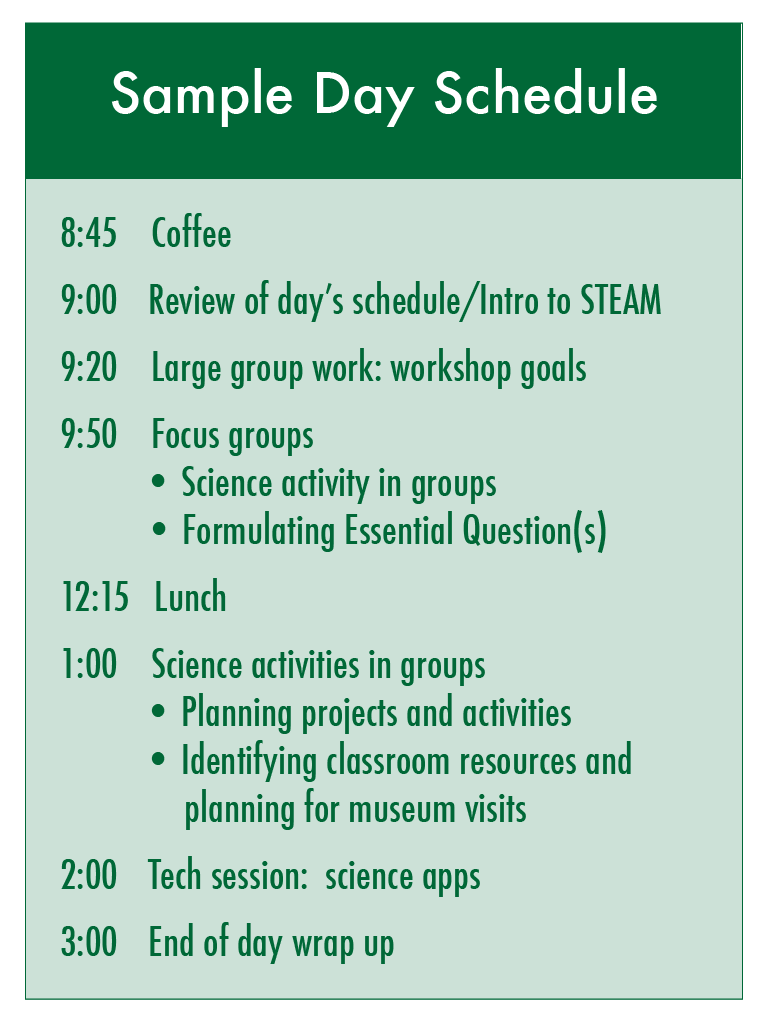
On the last day, teachers participating in the workshop invite principals, curriculum coordinators, and other administrators from their schools to see presentations about what they have learned. At least a dozen school officials came to support their teachers. Lisa Baglini, Educational Coordinator at West Haven Child Development Center, and a Seedlings alum, was one of them. “I have been in the program for the past two years, and I wanted to make sure that other teachers in the department had the same amazing experience,” said Baglini. “I am here to support my teachers, and to bring more of a focus on the importance of the environment and scientific study into our classrooms.”
Cook Hill teachers’ shared success from and enthusiasm for their Seedlings experiences have not only garnered the support of Principal Friend, but also of Wallingford Schools Science Curriculum Resource Teacher Kate O’Donnell, who attended the presentations as well. “I wish more of the teachers in our district could attend because that will really ignite that wondering, questioning, and noticing about the world that we want in science,” she said. Additionally, the integration piece is also big for O’Donnell. “If you can’t integrate in an elementary classroom where you have your kids all day, every day, where can you integrate? If you’re teaching science and you’re not talking about reading and writing and communicating and measuring and analyzing data, then you’re really missing that big piece. Engineering is the new piece of the Next Generation Science Standards, so it’s really exciting to see that teachers are ready to integrate that into their classrooms as well.”
